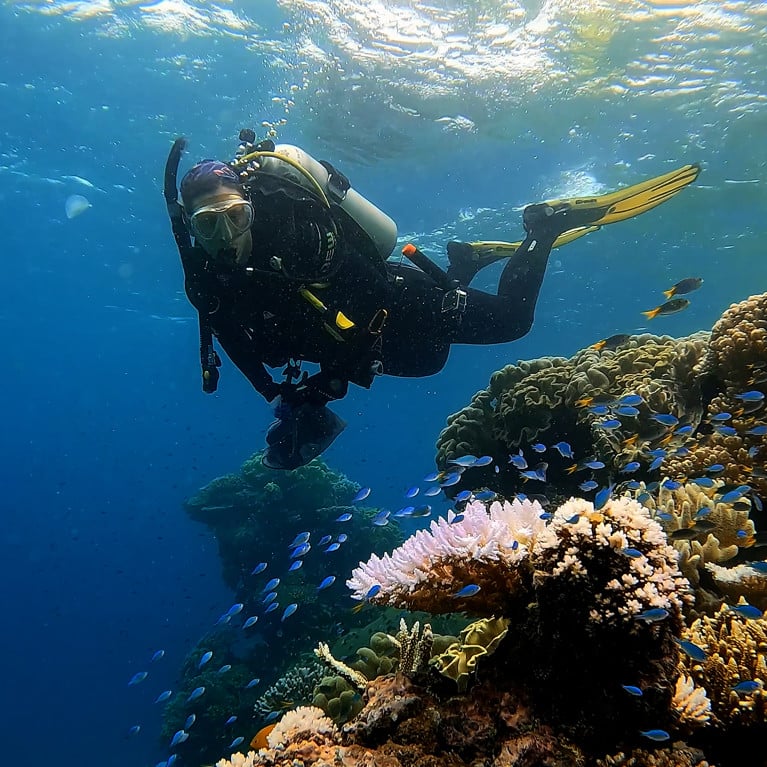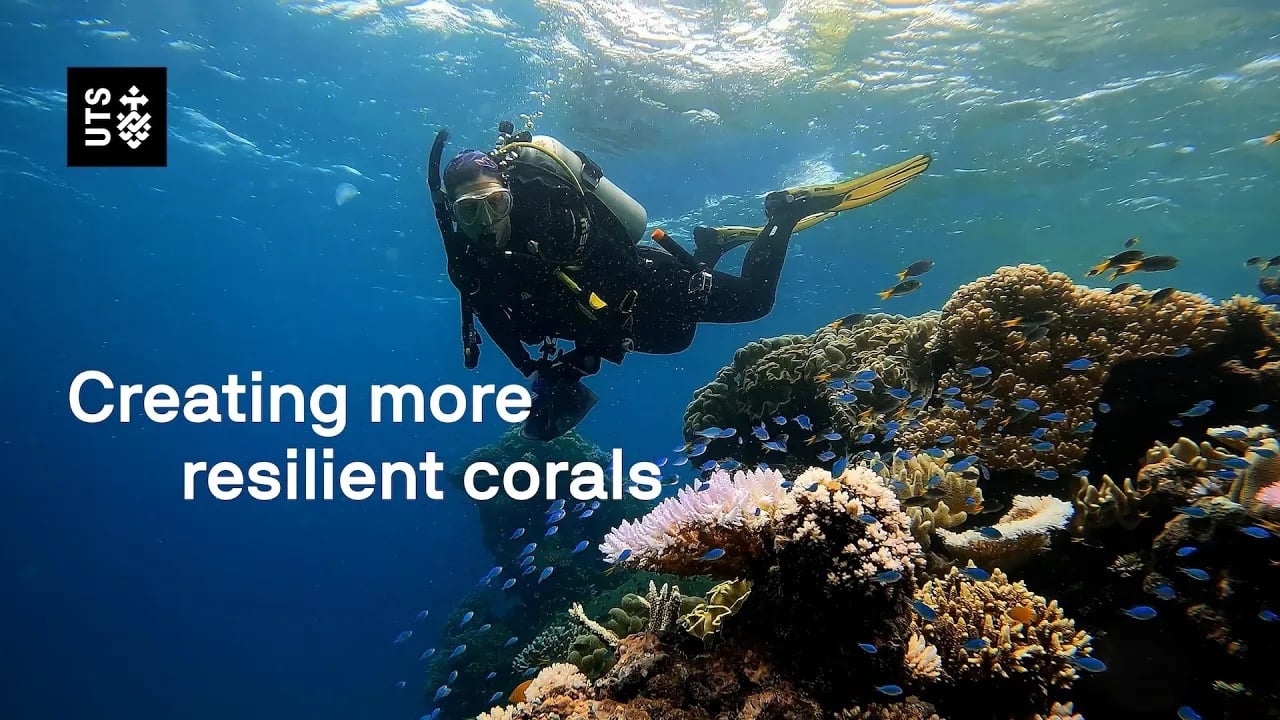There are few natural wonders as iconic and captivating as the Great Barrier Reef. It’s the feather in Australia’s cap – an incredible source of biodiversity and beauty that holds immense social, cultural, environmental and economic significance. However, this national treasure is in peril.
Pressures from climate change and other impacts of human activity are mounting, and the reef is struggling to remain vibrant and lively in the face of rising ocean temperatures, increased acidity, depleting oxygen levels, and localised stresses such as run-off and pollution.
“The Great Barrier Reef has been declining in coral cover since the 1980s, but we’re seeing an increased frequency and intensity with the rate of coral loss,” says Dr Emma Camp, a senior lecturer and Team Leader of the Future Reefs Program within the Climate Change Cluster at University of Technology Sydney.
“This means less corals on the reef, less diversity and less ability for the corals to reproduce, which leaves a dire threat for the Great Barrier Reef into the future.”
While researchers are furiously trying to tackle the issue from many angles, climate change remains the greatest threat to reefs around the world and presents an ongoing challenge for coral scientists like Camp.
Events like the 2023-2024 mass global coral bleaching, which affected over 80% of the world’s coral reefs including our own Great Barrier Reef, provide confronting evidence of the need to take action to protect the corals we have left and mitigate future die-offs.
“Coral reefs are the foundation for so much other marine life, so if we lose the home to those other organisms, some might be able to find somewhere else to live, but the reality is a lot of biodiversity will be lost,” Camp says.
“Knowing the immense stress that corals have to contend with now and into the future, as scientists we have to think: ‘What can we do to support their survival?’.”
Camp is among a group of researchers hunting for solutions that not only prevent further coral loss, but also encourage reefs to build resilience to withstand future stresses. Her research led her to looking in some unconventional places to see if there are already corals bucking the trend – and what we can learn from how they survive extreme conditions when other coral species don’t.
Finding a way forward
Camp has been fascinated by oceans her entire life – their wonder and beauty, the diversity of life and the fact that there is still so much left to learn and explore.
After completing her undergraduate degree in environmental science and chemistry, and during her Master’s in Environmental Management and Business, she undertook several internships that eventually put her on the path to becoming a coral scientist.
“I want to ensure that reefs are here for the future. I love them, and I want other people to have the opportunity to fall in love with them as well,” she says.
Camp travelled to the Cayman Islands for a research opportunity at the Central Caribbean Marine Institute. It was here that she received a Fellowship to undertake a PhD studying how habitats closely associated with reefs contribute to their health.
Her work caught the eye of the Australian Department of Education and Training, and she was awarded an Endeavour Research Fellowship in 2016 to conduct a novel study of corals living in mangrove habitats.
“We didn’t know if extreme coral-mangrove sites existed in Australia, but we had every reason to think that they would. And once we found them here and in New Caledonia, I knew these were globally important ecosystems for reefs,” she says.
“From there the scope of the work increased to thinking about what this means for the value of mangrove lagoons to corals.”
Joining the UTS Climate Change Cluster provided the perfect environment to expand on this work, and Camp has been a coral research lead at UTS since 2018, co-founding the Coral Nurture Program and ascending to the Team Leader position for the Future Reefs Team in 2023. In this role, she works with a team of more than 20 researchers who are on the front lines of fighting the effects of climate change on the Great Barrier Reef.
The Great Barrier Reef sustains more than 14,000 species of animal, including corals, fish, turtles, birds, sharks and dolphins.

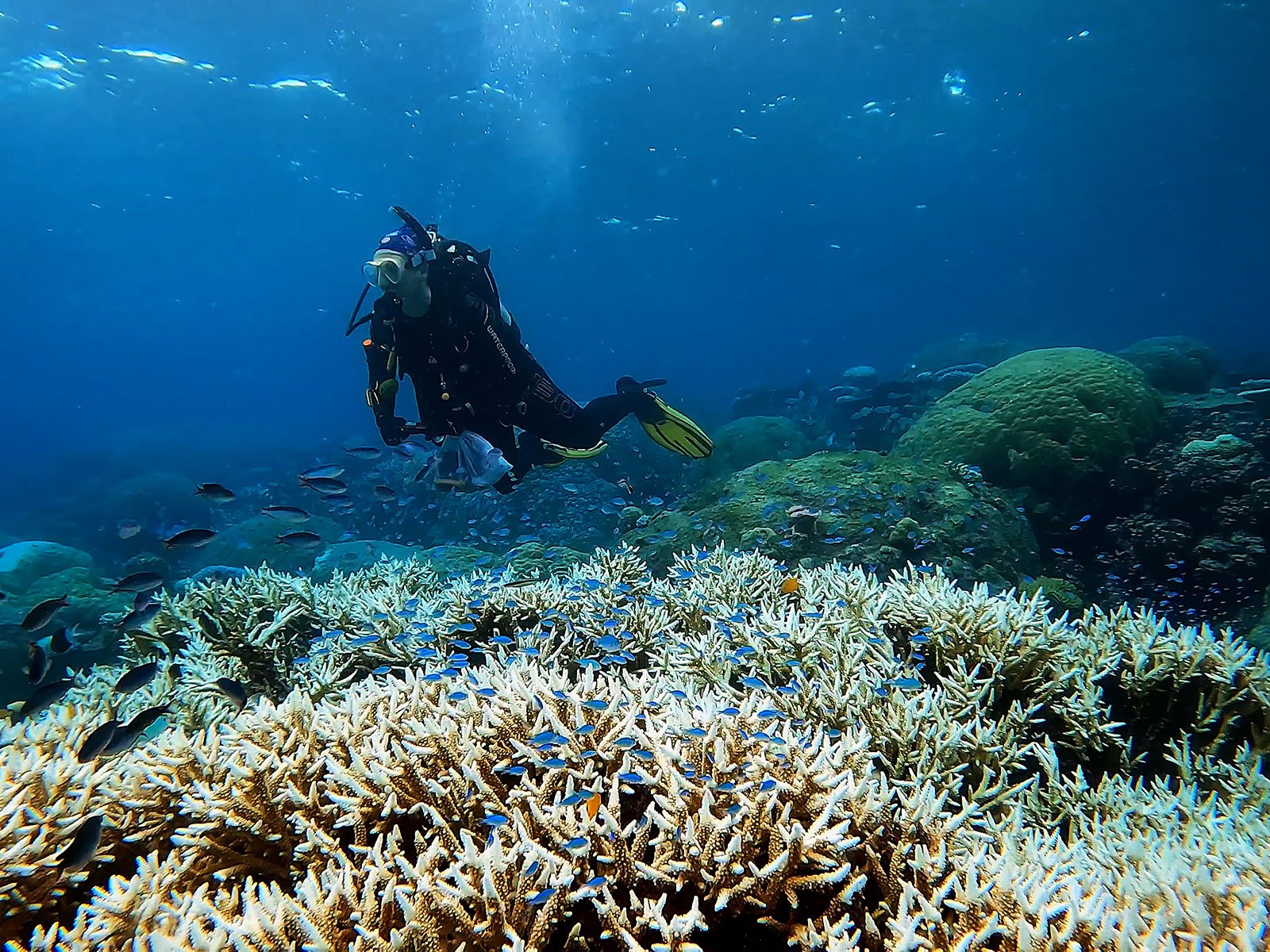
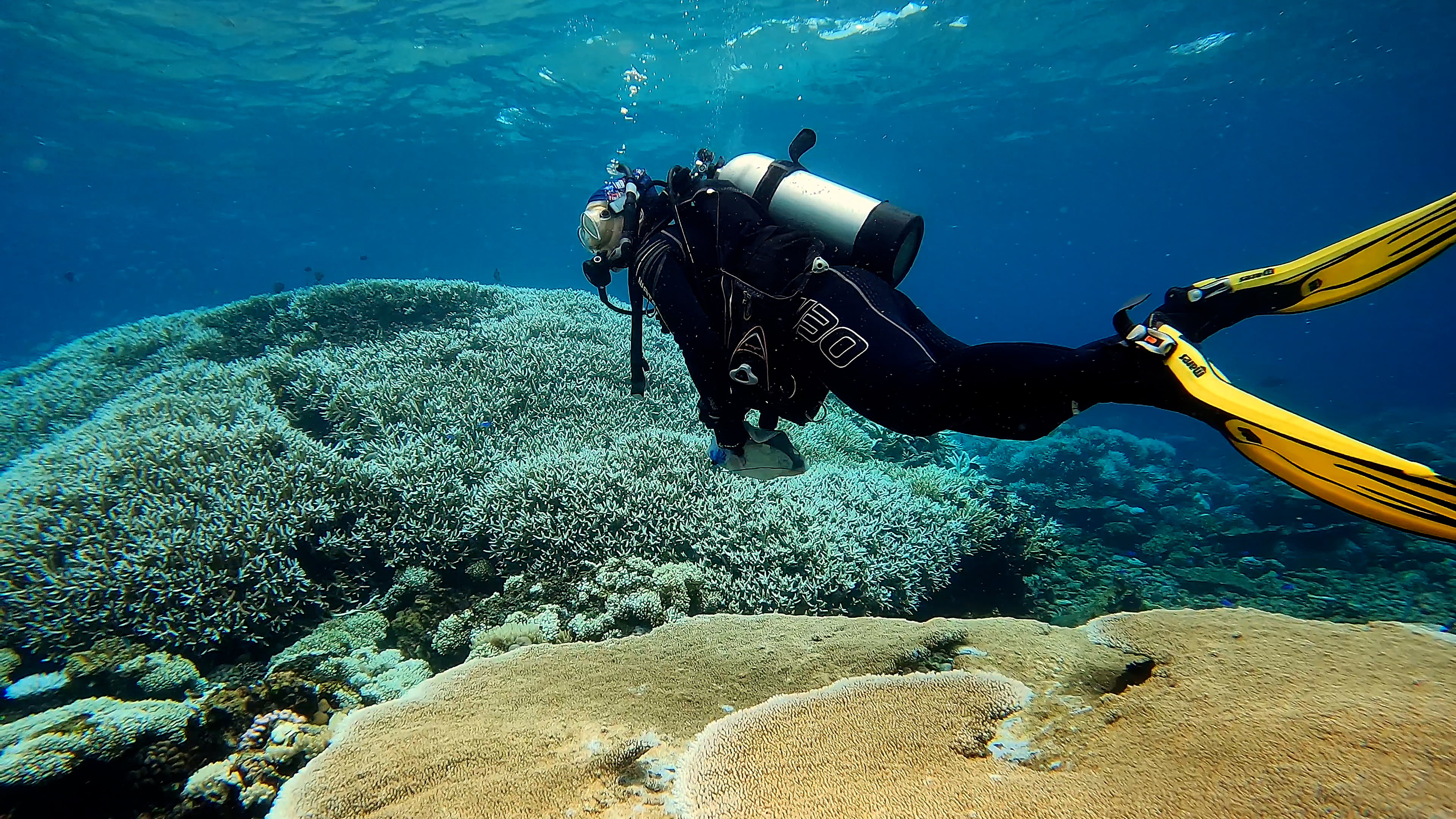
Searching for extremes
Suffice to say, there are few people better placed to answer the question: how can we build more resilient reefs that can weather the intensifying oceanic conditions caused by climate change?
Leveraging her work researching extreme environments, Camp determined that the best place to start was investigating what makes it possible for some species of coral to survive and thrive in environments where others can’t.
“For me it was asking: Are there already corals that exist in naturally hostile conditions – warm, acidic, low-oxygen environments, the exact type of environment we’re predicting the oceans to have in the future?” she says.
Mangrove lagoons have hot, acidic and low-oxygen environments. But they also have thriving coral communities.
“Finding corals living in these extreme mangrove environments has been a breakthrough because it gives us hope that some corals have the capacity to tolerate stress," Camp says.
She’s now studying the genetics, physiology, ecology and other factors of these corals – dubbed ‘super corals’ because of their superior tolerance to stress – to use them as blueprints for understanding coral resilience and developing techniques for translating this resilience to reef environments.
There are a lot of factors that contribute tolerance to these super corals, Camp says. Their genetic composition is slightly different. They have unique algae that associate with them, and they acquire and use oxygen in different ways. Mangrove lagoons also have different concentrations of nutrients compared to open ocean waters, and the team is studying how these nutrients contribute to superior tolerance and if this can be replicated in reefs.
Much of Camp’s research into super corals involves putting mangrove coral through its paces to test just how far it can be stressed before it dies. How tolerant are they to high temperatures? How acidic can water be before it has negative effects? How little oxygen is too little?
Number of inshore mangrove islands that border the Great Barrier Reef.
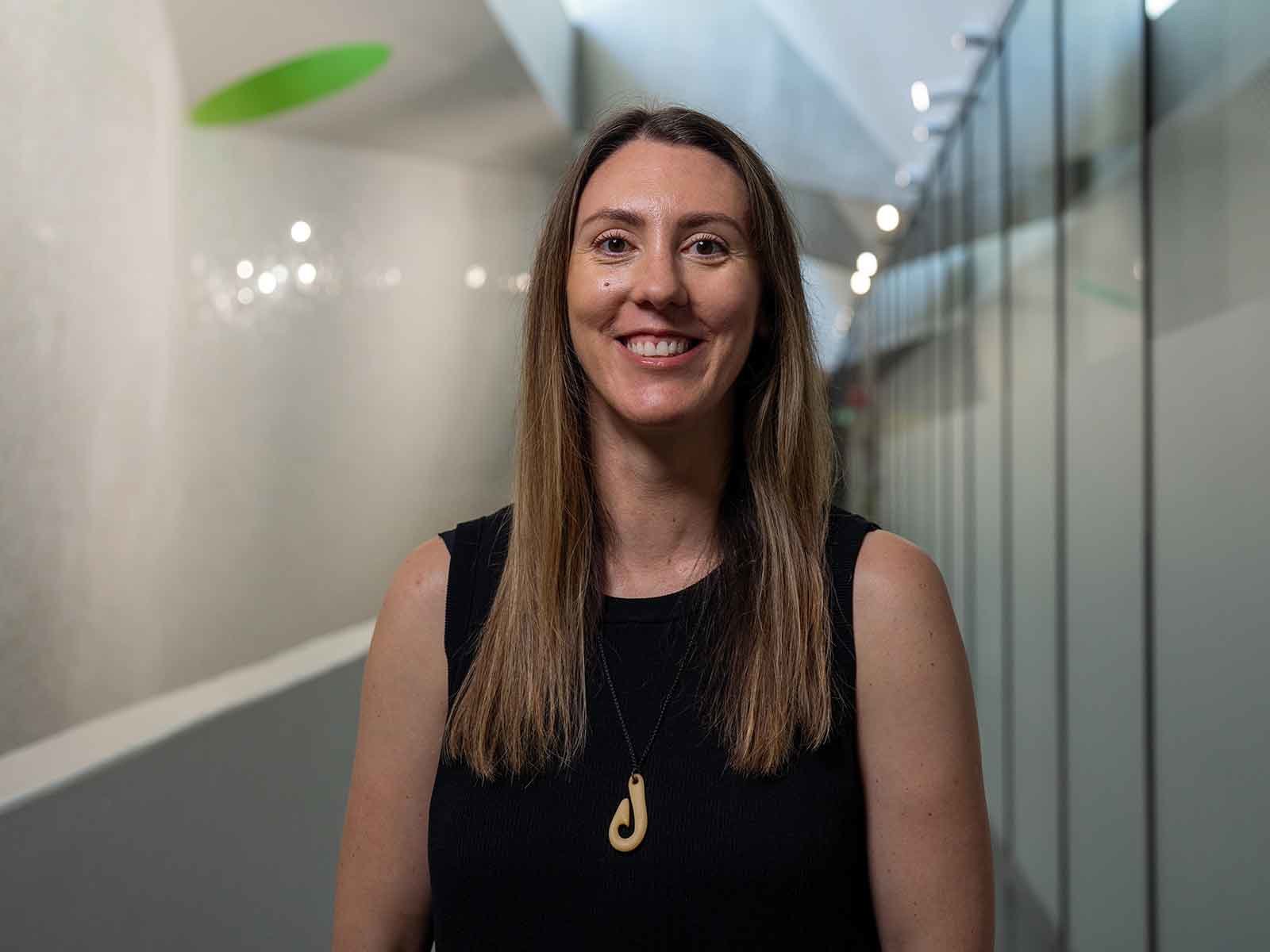
The team then takes the corals that do well under extreme conditions and analyse their DNA to isolate which genes, metabolic pathways and other factors help them survive. Super corals can also exist on regular reefs, and Emma’s team looks to try and identify these with novel technology, such as high-throughput phenomics methods.
Corals that demonstrate high tolerance are prime candidates for propagation. The team identifies the colony where test samples originated and then implants those corals in an offshore nursery. Researchers and local divers monitor the growth of corals and work to maintain the health of these sites. The end goal is to get more of these stress-tolerant genes onto the reef.
“We set up plots to be able to track corals over time, so we can see how response to stress events or how recovery happens differently in species,” Camp says.
“But even better is we can start to predict how different phenotypes behave under stress, and we can use that knowledge to inform our practice, so it’s iterative learning over time.”
Camp is also working closely with others to develop tools and processes that local practitioners can use to ensure they’re investing wisely in growing and implanting coral, whether that’s focusing on heat-tolerant species, better identifying at-risk species within local populations, or planting fast-growing species that fill an ecological niche.
“Normally the premise for restoration is that you remove the stress before trying to restore the environment – we don’t have that luxury with climate change intensifying stress on the reef,” Camp says.
“Instead, the question becomes how do we ensure we’re not wasting effort? How do we ensure that what we’re growing and planting has the best chance of survival and is giving the Great Barrier Reef the best chance to recover from stress?”
The Coral Nurture Program’s goal for the number of corals planted by the end of 2025.
Phenotype:
The observable characteristics or traits of an organism, which are the result of both its genetics and the surrounding environment.

A toolbox of approaches
Camp doesn’t believe that her research alone will ‘save’ the reef. Rather, she feels it’s best to have as many options as possible to tackle this grand challenge.
“Where the reef is at the moment, we need a variety of tools that are going to be suitable in different locations for different jobs,” she says.
“Super corals are one tool that we can use, but I think their biggest value is that we can use them as a blueprint and guide to learn about benefits across multiple different interventions.”
These interventions extend beyond marine biology and include collaborating with other disciplines to find new ways of thinking. Camp has tapped the expertise of microbiologists to study bacterial communities within coral, researchers from the UTS Business School to better understand the economics and financing of coral restoration projects, and members of the UTS Faculty of Law to explore the implications of coral loss on the rights of communities most affected.
“I think the problems that we face are not just biological,” Camp says.
"That interdisciplinary collaboration is going to be key to translate some of the ideas we have into solutions we can implement."
Camp is also very conscious of working with community groups, local industries such as tourism and agriculture, and traditional owners to find ways for science to meld with their needs and practices to build resilience – not just for the reef, but for these groups to thrive alongside the coral communities they rely on.
“When I think about my goal to have a healthy, functioning reef and to try and make a positive impact – if you want to translate the science into positive impact, that can’t happen without your end-users engaged from the beginning,” Camp says.
“We’re very much looking to leaders within these groups to see how we can collaborate and learn from each other. The state of the reef is such that it’s degrading rapidly. We’re having to make decisions and look at things like risk and figure out how to upscale our work, and that requires expertise beyond academia.
“Through close, meaningful relationships with community groups, tourism operators, other industry partners, government, traditional owners, you can see where the need is and then tailor your science to that need to help you have the most benefit.”
Science-informed stewardship is very important to her, and she is passionate about ensuring local communities are not only involved in the decision-making about coral reef preservation, but that they have a sense of ownership and empowerment in helping to responsibly care for and restore the Great Barrier Reef.
“It’s about capacity-building within communities so they can contribute to the management of their local reef sites and contribute to the long-term health of the reef,” Camp says.
This looks like training to recognise and safely remove invasive species, raising the alarm about disease outbreaks or monitoring for coral bleaching.
“The impact of our research has been new knowledge on coral restoration that we can share with communities around the world, but also with reef managers looking to inform how they should undertake conservation on the reef, the role that restoration can play, and ultimately how we best sustain the value that coral reefs provide for communities globally,” Camp says.
“This is an entirely different view and lens of looking at how can we try to empower communities and individuals to advocate for positive action on climate change to ensure a future for reefs. We’re looking at science to try and buy time for reefs, but also how can we collaborate with other industries and speak with other people to ultimately shape and inform policy that’s needed to safeguard reefs in the long term.”
The size in km² of the Great Barrier Reef – almost as big as Italy.
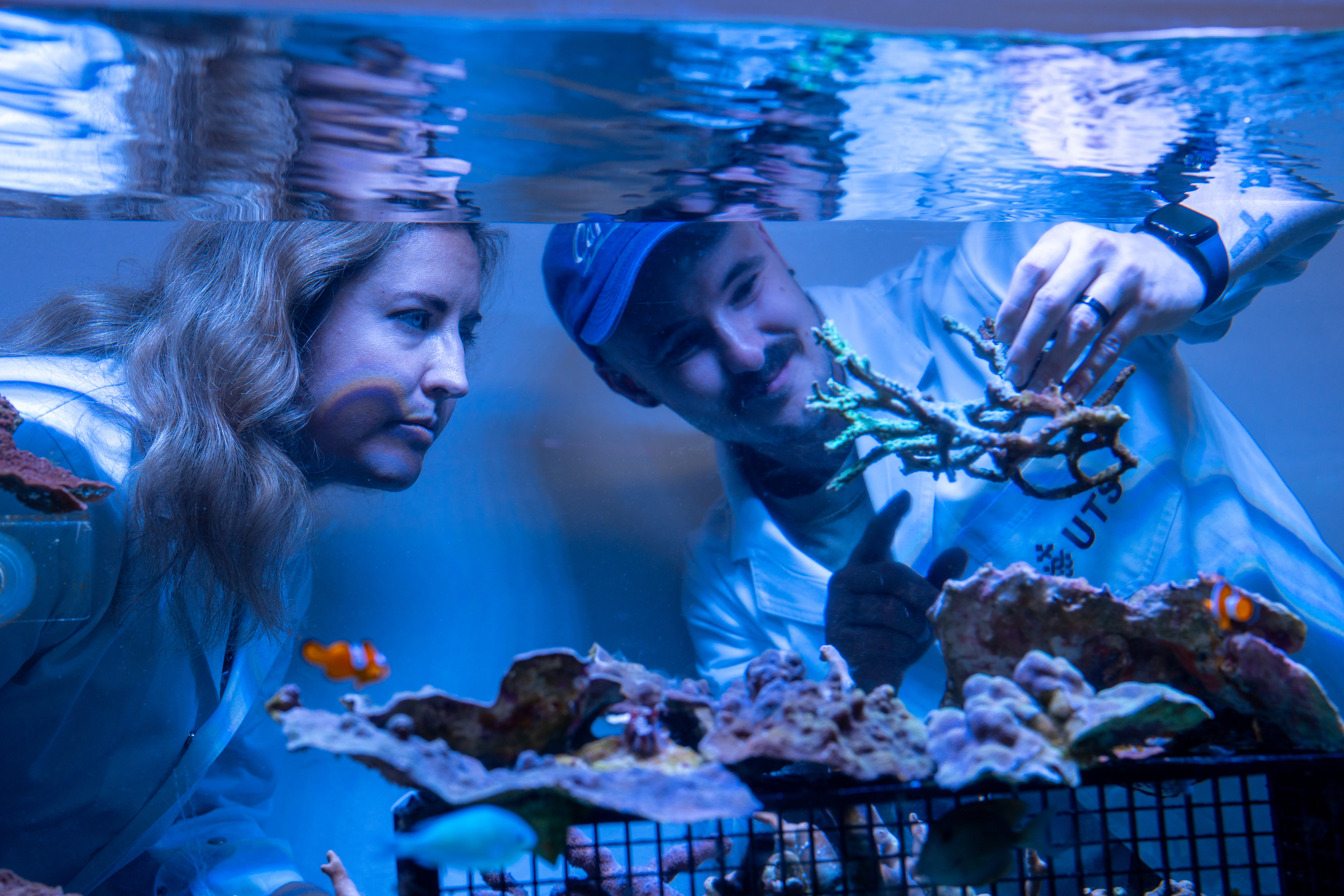
Preventing future loss
If the Great Barrier Reef and other reefs around the world were to disappear, the loss would be profound. Without reefs to serve as barriers, coastal and island communities would be immediately affected by increased erosion and flooding. Reefs also hold immense economic, cultural and social significance for close to 1 billion people globally, many of whom are vulnerable with limited political power and resources to do something about this dire situation.
“That’s where science has a really crucial role to try and ensure the conservation of this resource – not just for these environments but for the people that are reliant on them,” Camp says.
This point in time is particularly tricky, though, because researchers, government officials, industry bodies and regulatory agencies are having to make decisions in parallel with scientific discovery.
“We don’t have all of the information we would like to have to be able to confidently make decisions that affect the long-term outlook of the reef,” Camp says.
“So we’re having to evaluate the risk of doing nothing against the risk of what we know is going to happen if we do nothing, which is likely loss of reefs.”
It’s a complex landscape to navigate and requires being comfortable with some ambiguity. However, Camp is encouraged by the momentum that’s building within communities, academia, industry and government to work together on finding solutions to this daunting challenge, and she is “cautiously optimistic” that we’re headed in the right direction.
“We know what the problem is, which means in principle we have every tool that we need to do something about it,” Camp says.
“The reef is naturally resilient, and these super corals are an example of that. It’s an example of how nature can surprise us. I’m not under any illusion that reefs will look the same in the future, but I remain optimistic that there will be some corals and some pockets of reefs left from which we can hopefully rebuild once we tackle the climate crisis.
“And so if nature and the reef can show us its resilience, we need to be resilient and support it.”
Estimated economic, social and icon asset value of the Great Barrier Reef.


